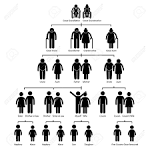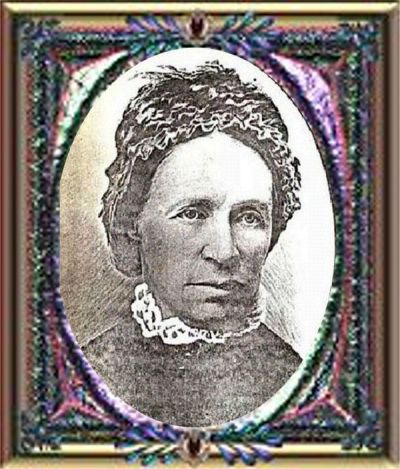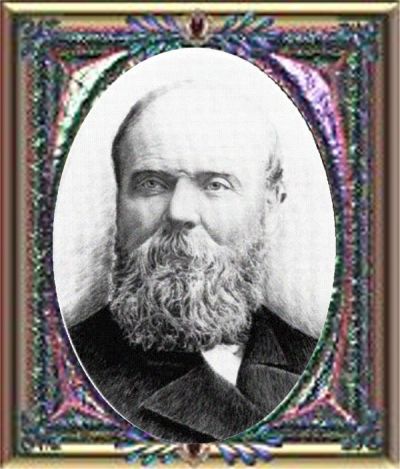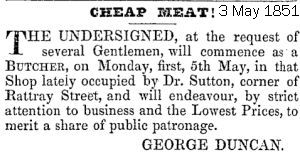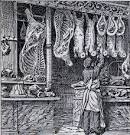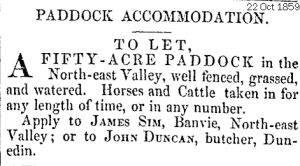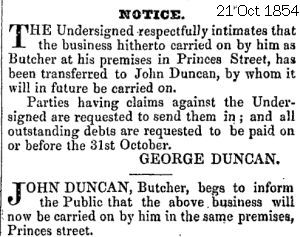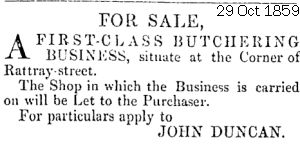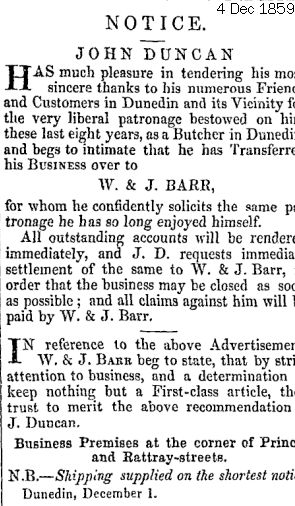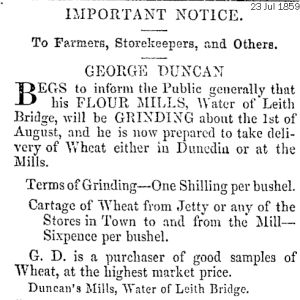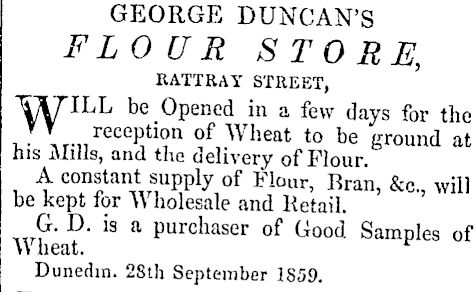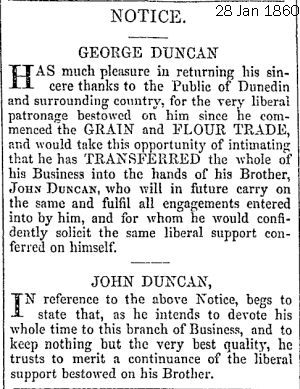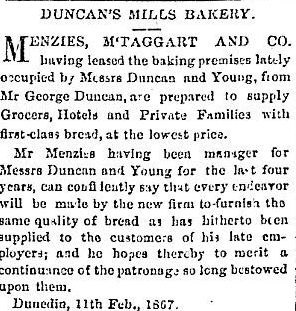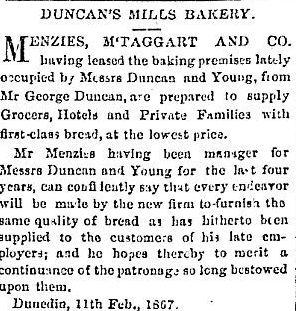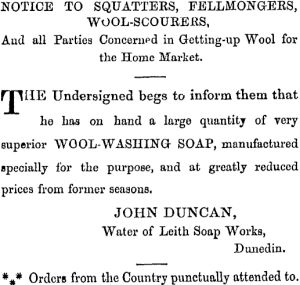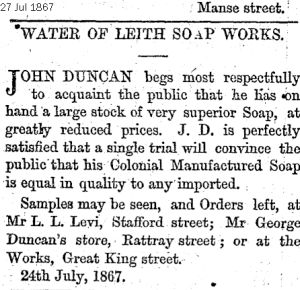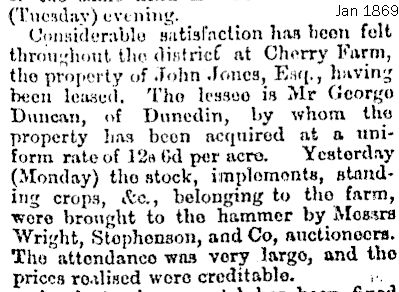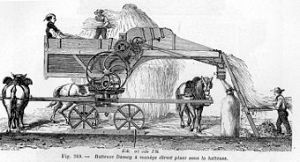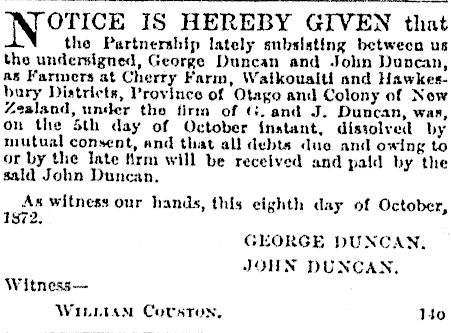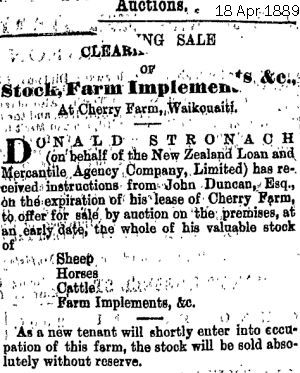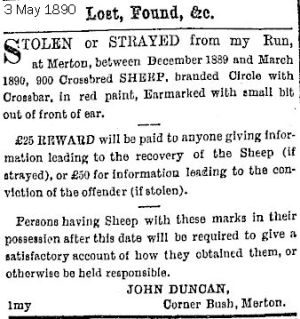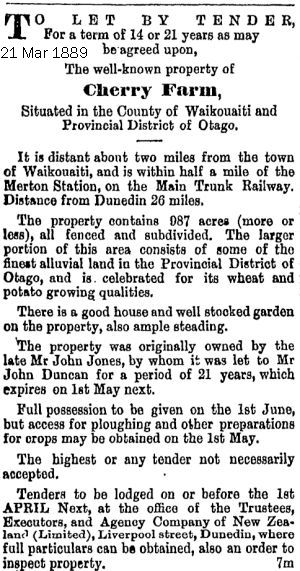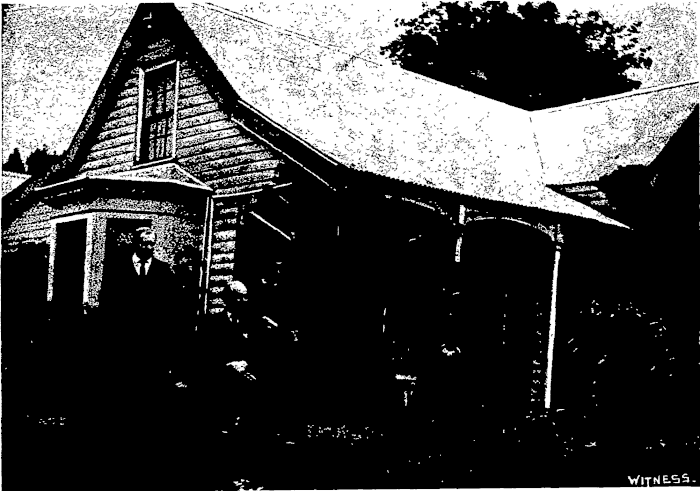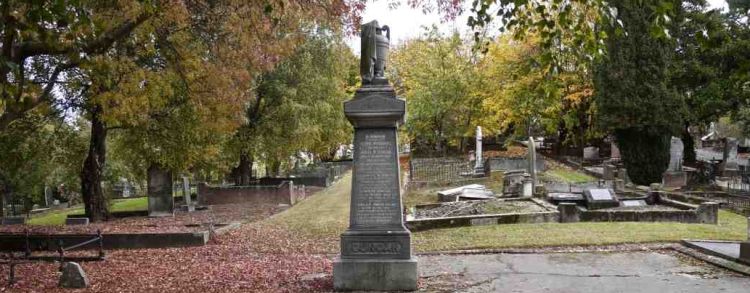|
J OHN DUNCAN was b: Aug 1828 in Nether Banchory, Aberdeenshire, Scotland, the 2nd son of James Duncan b Banchory Devenick, Kincardine, Scotland, d: March 26, 1912 aged 83Y at Dunedin - James mar: 03 Apr 1823 in St Nicholas Parish, Aberdeen, Scotland to Mary nee Greig (b: 10 Apr 1803 in Aberdeen Bapt: 14 Oct 1801 St Nicholas Parish, Aberdeen; Father: George Greig Mother: Janet Connon; ) she d: 24 Aug 1887 aged 52Y in Dunedin Bur: 26 Aug 1887 Southern Cem, Dunedin Block 24 Plot 5 Bapt: 11 Sep 1828, Banchory Devenick, Kincardine, Scotland)John Duncan immig: 26 Dec 1849 to Dunedin, New Zealand; he d: 26 Mar 1912 in at his residence 1845 Cumberland St. Dunedin in his eighty-fourth year; Bur: Southern Cem. Dunedin.) John's siblings: (b: 06 Jun 1826 in Branchory Devenick, Aberdeen, Scotland; d: 13 Jan 1879 in San Francisco County, California; Bur: 29 Apr 1879 Southern Cem, Dunedin Block 24 Plot 5) Mar: 27 Aug 1849 in Old Machar, Aberdeenshire, Scotland to Elspeth Wilson (b: 1829 in Barnff, Aberdeenshir Scotland d: 04 Apr 1910 in Dunedin; bur: Dunedin Southern Cem) In 1859 started the Water of Leith flour mills. Having amassed a competence he entered public life, first in 1860 as member of the Town Board, and in 1863 a member of the Provincial Council for North Harbour district, Secretary for Public Works 1863, resigned in 1864 and visited Scotland. In 1867 he was returned for Dunedin, and for six years was almost continuously in office. In 1873 he resigned his public position, disposed of his estate, and left for California, where he d: in Jan 1879, aged 52 years. iv James Duncan (b: 1833 in Nether Banchory; d: 31 Aug 1918 aged 84Y in at his sister Agnes's house, 72 Arthur St, Dunedin; bur: Dunedin Southern Cem) v Agnes Duncan (b: 18 Aug 1834 in Banchory Devenick, Kincardine, Scotland Bapt: 28 Aug 1834 Banchory Devenick, Kincardine, Scotland d: 11 Oct 1920 in Duncan St, Dunedin) Mar: 03 Aug 1855 in First Church, Dunedin to James Pollock (b: 1833, d: 1883 aged 50Y; bur: Dunedin Southern Cem) The Duncan's immigrated to NZ on the "Mooltan" departing from Greenock, Scotland, 11 Sept 1849, and arrived at Port Chalmers, New Zealand, 26 Dec 1849. (Passenger List) Cholera broke out, but Dr. Purdie succeeded in banishing it2 Oct 1852: To vote one had to own property Opposition to claimants came invariably from Government officers, and every claim that could possibly be thrown out was rejected - John Duncan's claim was objected to on the ground of his brother had a vote for the same premises - the court disputed there be no objection, so his claim was allowed.John mar: MARY BEATTIE on 15 Feb 1853 in Waikouaiti, Otago, the daughter of JOHN BEATTIE. (She was b: 1835 in North Berwick, East Lothian, UK, and d: on the 24th April, 1887 aged 52 years at Keith Hall, Greytown, Taieri, Otago, home of Wm Shand, farmer (his wife Ann Christie had also arrived 1849 on the Mooltan) Beloved wife of John Duncan, Cherry Farm, Waikouaiti; Bur: 26 Apr 1887 Dunedin Southern Cem. Block 24. Plot 5. Children of JOHN DUNCAN and MARY BEATTIE are:
After their arrival in 1849, brothers George and John relished the opportunity to take up new challenges - moves would be spearheaded by George then after working together, John would take over the running of the operation. John found difficulty to source meat for their first enterprise due to the lack and state of early roading aften without bridges - they required holding paddocks for stock and slaughter facilities and had shops in both Princess and McLaggan Streets - they excelled as butchers in a province with a population swollen by the discovery of gold.
George took over the Commercial Hotel in High St in Oct 1856 and John sold the butchers shop in 1859 and they next started the flour mill at the Water of Leith as the small mill at Woodhaugh was unable to grind all the wheat grown in the district. Local bakers were used to Adelaide wheat and were prejudiced against the local grown production so the Duncans started their own mill and bakery to demonstrate the quality of the local flour.
Another enterprise John undertook was making soap
In Jan 1869 George and John Duncan leased Cherry Farm at Waikouaiti, tenancy for a period of 21 years. Hawksbury was also known as "Cherry Farm" (and sometimes erroneously as "Evansdale"), is a small residential and industrial area beside State Highway 1 between Dunedin and Waikouaiti On the 4th Oct 1872 a disastrous fire in the Dunedin Grain Mill saw George relinquishing his share in the farm property to John who purchased also on the 5th Aug 1871, Corner Bush farm at Merton - here the family lived. John was a Member of Land Board 15 years.
Bruce Herald, 17 Oct 1873: "I visited on my way,
Cherry Farm, the leasehold of John Duncan, Esq. Mr. Duncan's farm contains
200 acres of wheat, "red straw" now a foot high, and looking splendidly,
He has altogether about 4,000 acres of the sheep
run and farm. His stock are choice, having taken no less than 12
prizes at this last Blueskin Pastoral and Agricultural Show. To show the
root crop capabilities of this farm, I may mention that from 40 acres of
potato crop the yield, was 500 tons. Mr. Duncan showed me some of these,
and I doubt if the far-famed Clutha land could turn out anything 1 finer.
Mr. Duncan has added lately to his draught stock two brood mares of
imported stock, by Mr. Valpy. Their sires were Prince Royal and Champion.
He has also some choice pigs. In a snug wool-shed he shears his 4,000
crossbreds and Leicesters. I next visited his barn, where he cuts and
bruises his chaff and oats. The machine employed for crushing is a
Ransome and Sims' Bruising Mill. It is supplied from a loft by means of a
canvas feeder. A double pulley and belt works the chaff-cutter in
conjunction with the bruiser. Bruising oats is a great improvement in
feeding economy, As it not only embraces all classes of grain, but suits
all ages and stomachs of horses, thus giving them extra power through
their food. I saw two double-furrow ploughs, three reapers, and other
agricultural appliances too numerous to mention. I next took a look at
some splendid peach trees in full blossom trained against the wall of the
stable. Mr. Duncan's garden is beautifully laid out, and the handsome
addition which he has made to the dwelling-house produces a neat and
comfortable effect. The garden in connection with the house contains some
fine pear and cherry trees, while a beautiful clyanthus raised and shaped
by Mr. Duncan occupies a front central position. This tree is a fine
example of what may be done with a rough growing shrub.
7 Mar 1874: John Duncan Evening Star, 3 May 1879: The sub-divisions of sections in Rattray street, belonging to Mr John Duncan of Cherry Farm, were offered, and sections 1, 9, and 7 were sold at £205, £I05, and £165 each. The balance are for private sale. Evening Star, 1 Jun 1878: Messrs Fleming and Hedley report that they submitted to public competition at their rooms last week that valuable station in the Canterbury district, being runs No. 171, 10,000 acres, and No. 68, 9,783 acres, subject to an annual rental of £ 197 17s, together with between 7,000 and 8,000 sheep. There was a large attendance of those interested, and the bidding, up to a certain point, was very spirited. The runs were eventually sold, after a keen contest to Mr John Duncan, of Cherry Farm, Waikouaiti, for the sum of £8.600, including advance rent; stores and furniture to be taken at valuation. Otago Daily Times, 29 March 1880: CROWN LANDS SALE AT WAIKOUAITI: Waikouaiti District, Section 11, 312 acr 12p, and section 13, block VIII, 227 acr 13p, upset price 20s per acre to Mr John Duncan, Cherry Farm. Otago Witness, 3 July 1880: WAIKOUAITI PLOUGHING MATCH. Held at Mr John Duncan's, of Cherry Farm in his paddock - it is situated about a mile from Merton, and two miles from the Waikouaiti station Otago Witness, 12 April 1884: FARMING IN OTAGO.We think we may safely assert without feat of contradiction that the present harvest is the most bountiful that the settlers have experienced for many years, if, indeed, it has ever been excelled. Taking the crops throughout this and the Waikouaiti district on the general average, they will be found the heaviest in straw, in wheat, and oats with a-corresponding yield. At Cherry Farm in the Waikouaiti district, Mr John Duncan has had a remarkably heavy crop of oats. la one paddock the stooks were literally crowded together; the sight was, in fact, quite a picture, and afforded ocular proof, with a favourable season for the growth of cereals, of the extreme fertility of the soil. The other crops have been correspondingly heavy, but of course it must be understood that Mr Duncan adopts a proper system of farming 28 Apr 1889, COMMERCIAL; Cherry farm has been leased to Mr McBride. of Palmerston, whose tender has been accented by the owner at 10s 6d per acre, being 2s 6d above the offer of the present lessee, Mr John Duncan. Evening Star, 11 May 1889, The New Zealand Loan and Mercantile Agency Company held an extremely satisfactory sale of Mr John Duncan's surplus stock and implements. There was a very large attendance, bidding was keen, and prices on the whole must have been highly gratifying to the vendor. Sheep especially sold capitally. Two-tooth to four Leicester breeding ewes brought 14s 3d, wethers 14s 9d, lambs 8s 9d, and other sheep similarly good figures. Draught brood mares realised from £34 10s to £l0 l0s. Dairy cows went up to £8 2s 6d. Pigs were well competed for, prices ranging from £37 6d to 14s. Implements, furniture, and odds and ends were also disposed of at fair rates (John Duncan - his Time Line - Reported in Otago Witness, 25 May 1878): CHATS WITH THE FARMERS. A Visit to Mr John Duncan's ESTATE, Cherry Farm, Waikouaiti. Mr John Duncan arrived in Dunedin, from Scotland, with his brother Mr George Duncan (now in Oregon) in 1849. Business at that time was very dull — working-men's wages, when they could obtain employment, being 2s 6d to 3s per day. The prospect was most discouraging. It was evident that it would be impossible to make headway without hard work, great self-denial, and the most careful management. They were young and strong, however, and were endowed with a more than ordinary degree of energy and native wit. With brave hearts they went to work. For some time profits were very small, but by observing the maxims for making money - the chief one of which is to live within means, they made some progress. Their first great achievement was the erection of a mudhouse in a swamp, upon the site of the Albion Hotel, Maclaggan street. Their next was the building of a boat with their own hands, for the transportation, to Dunedin, of timber which they had sawn at Anderson's Bay. In the course of ten years they accumulated a good sum of money and Mr G. Duncan went on a visit to the old folks at Home. Mr John Duncan, in co-partnership with Mr Young, leased a flour mill at the Water of Leith. At that time. Otago-grown wheat was considered only suitable for horse-feed, and the best bread was made of Adelaide flour. Messrs Duncan and Young therefore had great difficulty in finding a market for their flour. Bread at this time was ls 6d the 4 1b loaf. Some of the bakers mixed it with Adelaide, but others would have none of it at any price. Sooner than make use of it, they would pay £6 more per ton for Adelaide! Of course, the settlers in early days were glad enough to have bread made of home-grown wheat, but probably the millers did not make the flour quite so fine as the imported. At all events, the bread made from New Zealand wheat did not suit the Australian gold-seekers, who had been used to bread of the best quality, made from the finest silk-dressed flour, which was not half so wholesome as that made in the rougher manner. Messrs Duncan and Young struggled on, until one of those floods came which periodically visit the Taieri. They had got a quantity of wheat which, in consequence of the flood, turned out badly in the mill. They were in an unfortunate predicament. A large stock of flour was on hand, but there was no market. Their only alternative was to compete with the bakers. An oven was erected,. and they commenced manufacturing bread. It proved to be of good quality, and it met with a ready sale. Duncan's bread was the poor man's loaf, and there was a rush for it, at a reduced rate. A second oven was put up, and both were kept going day and night, Adelaide flour being, of course mixed with that from the Taieri wheat. New wheat came in, and the loaf improved in quality. The bakers, seeing that Duncan and Young were making bread equal in quality to that from the Adelaide flour, began to think better of the home-made article which they had previously despised, and the consequence was that there was a run upon the mill for flour. Improved milling machinery had been introduced, and Messrs Duncan and Young did a good trade until 1868 in supplying the market with a first-class quality of flour from Otago-grown wheat. The result was that Adelaide flour was driven out of the market, and the bakers were enabled to supply as good a loaf for 6d as that for which they had previously charged three times the price. In 1869 Mr Duncan, in co-partnership with his brother, Mr George Duncan (who afterwards sold out), leased the Cherry Farm, Waikouaiti, for a term of twenty-one years, and soon afterwards purchased 3000 acres of hill-land or grazing country close by. The farm consists of about 1000 acres of flat alluvial land, bounded on one side by the Waikouaiti river, and surrounded by hills. The river, no doubt, at one time made a bend in this basin, and gradually filled it up. The soil is a deep sandy loam, and the subsoil a sandy clay, and as might be supposed it is remarkably fertile. It was a choice selection made by Mr Johnny Jones before the days of the Otago Company, and was used by him as a grazing and agricultural farm. It was represented by the trustees of Mr Jones' estate as being under English grass. Messrs Duncan, before taking it over, examined it, and had it inspected by an experienced agriculturist. Upon taking possession, however, greatly to their horror and surprise, they discovered that the whole farm was overrun with couch-grass, and in its then condition was absolutely unfit for cultivation. When Mr Carmichael, of the Taieri, informed us of the disappointment which he experienced through having imported worthless couchgrass seed, we told him that he might consider it a fortunate circumstance, as the grass, if once sown upon the embankments, would probably spread all over the farm' and monopolise the ground to the exclusion of everything else. Such had been the case on some of the plantations of Louisiana. It appears that Mr Jones had sown couch-grass among other English grass seeds, and it took entire possession of the land. The leading authorities upon practical husbandry specify clearly the kinds of grasses which should be sown for permanent pasture, and couch-grass most decidedly is not one of them. The process of destroying this grass is a tedious and expensive one, and we certainly think that Mr Duncan is equitably entitled to compensation. This couch-grass (Triticum repens) is also called twitch-grass, quick-grass, witch - grass, dog-grass, and creeping wheat-grass. It extends rapidly by means of creeping roots, forming a mat in the ground, and taking entire possession of the soil. The first year 70 acres were cleared, at an expense of £8 per acre. Thirty acres per annum have been cleared since, and there are two or three years' work yet. The ground is ploughed in the autumn, and allowed to lie until winter, when it is cross-ploughed. After the roots have been exposed for a time, the ground is grubbed and harrowed, men following with forks and gathering the grass, which is carted off. This grubbing is repeated five times, and afterwards no less than seven times. A dead creek upon the estate contains hundreds of tons of the grass, which have been carted off the land. The first crop grown upon this reclaimed land is turnips or potatoes — the average yield of the former being 40 tons to the acre, and of the latter 12 tons. A crop of wheat is then taken off, and it is sown down in rye-grass and clover. The crops grown at Cherry Farm this season are 220 acres of wheat, 120 of oats, 18 of turnips, and 12 of potatoes, the remainder being in English grass, There are 200 horned cattle, 1000 sheep, and 60 horses, and on the hills 2500 sheep. The usual average quantity of wheat grown to the acre by Mr Duncan is 40 bushels, and of oats, 50. This year the average product of wheat is 45 bushels, and the 12 acres planted in potatoes have yielded 150 tons. Mr Duncan has tried red chaff, Tuscan, and red Straw wheat, and that which has been found to produce the best crops is the red straw. Of oats he has tried several kinds, and prefers the Danish. Cherry Farm potatoes are well known for their fine quality, and always bring the best price. Decidedly one of the best paddocks of turnips, if not the finest, we have ever seen was at Cherry Farm. They were sown in drills. The roots are of enormous size, and the tops cover the ground completely. There was not a blank, and they were clean and well cultivated. Mr Duncan, while having by the adoption of the system already described, first eradicating the couch-grass plague, then sowing in turnips, taking a white crop, laying down in grass for two or three years, and feeding stock — brought his land to a high state of productiveness, has not been unmindful of the importance of dealing only with the improved, breeds of animals. His herd of horned cattle represents some of the best Shorthorn strains in the Colony. He commenced with stock of Mr Murray's breed. At the sale by Mr Bell, of Waimea, he purchased two heifers which cost over 100 guineas each. He commenced with Mr Matthew Holmes' famous bull, Waterhouse, who has a stud-book pedigree. He was, when purchased by Mr Duncan, two years old, and valued at 250 guineas. He then bought from Mr Holmes seven of his pure Shorthorn heifers at large prices, Waterhouse took a first prize at Oamaru, and has since taken first honours at several Shows. Last year, he and two of his progeny took first and second prizes. Cows, heifers, and yearlings from the herd also took first and second prizes. There are now quite a number of purebred cows, whose young meet with a ready sale. The steers are sold to the butcher at 30 months to three years. They run in paddocks all the year, being kept in good condition by most excellent pasturage, straw, and turnips. The straw is stacked in the grass paddocks not very far from the turnip field At certain seasons Mr Duncan buys stores to fatten for market, but the margin of profit is so small, that he keeps as many cows as possible to rear calves from for fattening. There are on the farm twenty breeding mares, thirteen of which are Clydesdales, and having an interest in the Company's fine entire, Sir George Grey, Mr Duncan turns out some splendid young draught stock. Last year he had ten foals by him, and this year he expects to have twelve or thirteen. Before Sir George came out, mares were sent to Mrs Nimmo's. Sir George's two-year-olds were first and second at Oamaru, and second and third at the Taieri. Several young things were sold lately at good prices. Mr Duncan's three thousand acres of freehold hill land is bounded on one side by the Waikouaiti river, and that the remainder has a fence of posts, top-rails, and five wires. Here 2500 sheep, of a cross between the Lincoln and Leicester, are kept, and on the farm there are about 1000 sheep — 400 of which are Leicester ewes, and the remainder are half and three-quarter bred Lincolns and Leicesters. The breed with which Mr Duncan commenced was the pure Leicester. They, as well as the Merinos were subject to foot-rot when kept upon the farm. He tried Romney Marsh, expecting that they would be free from attacks of that disease in wet seasons, but such was not the case. He then got some of Button's breed of Lincolns, which with the Leicesters make a splendid cross, showing a decided improvement in the quality of the wool, as well as in the weight and quality of the mutton. The half-breds are kept on the hills, the aged being culled and fattened on the farm for market, while the young are sent from the low land to the hills. Mr Duncan remarked, that he thought a good deal of Mr Walter Miller's ideas in regard to sheep, as published in Tub Witness, knowing him to be an authority on wool-growing in New Zealand, and he hoped to profit by his advice. Mr Duncan has washed his sheep in cold water, for six or seven years, always before noon, and he gets from 30 to 33 per cent, more for washed than he could obtain for greasy wool. It does not lose more than 20 per cent, in weight. It would be unfair not to notice the trophies won by Mr Duncan's stock at the various shows. Upon his side-board we noticed a splendid silver cup, valued at 25 guineas, gained at Blueskin in 1874, for excellency of stock, imported by Mr Hislop. Messrs Wright, Stephenson and Co.'s silver cup, won at Palmerston in 1875, for the highest number of points in stock, was also there, as well as another cup for the same year. Upon the mantelpiece are two emu eggs, mounted by Mr Hislop in silver, in a most artistic style, valued at 20 guineas ; they were gained at Blueskin, in 1875, for excellency of stock. There were also quite a number of silver medals, which would have shown to greater advantage if they were in a more useful or ornamental shape. Cherry Farm is well supplied with buildings and agricultural implements. The wool-shed has every convenience and accommodation for eight shearers. In the steading there are stalls for thirty beasts. The barn is 60ft. by 30ft., and a shed adjoins f»for a nine-horse Robey engine, which runs a thrashing machine, chaff-cutter, and oat-bruiser. Then there are various other buildings, such as stables, carriage-house, blacksmiths' and carpenters' shops, and an implement shed 100 feet long. There is a fine comfortable house for the single men, and cottages for the married people who work on the estate. We must remark in reference to the farm buildings,
that they have not been erected in accordance with any well recognised
plan. Instead of being compactly arranged in a central position they
are detached and scattered in a way that must be very inconvenient. There
are three reaping machines, and four double-furrow D, and two or three
swing ploughs are worked. The double furrow used are made by Jack, of
Oamaru, and Reid and Gray, of Dunedin. There is a potato digger,
seed-sower, horse-rake, various rollers, grubbers, harrows, &c. The
potato digger, which is of Scotch make, has proved a great success.
Lifting with the plough and bagging, costs, about 6s. per ton, and with
the machine the cost is 4s., and the work is done better, easier, and in a
shorter time, besides leaving the ground better pulverised. It has been
used three seasons. The sower is by Young, of Ayr, and works very
satisfactorily. The grubber, which is made by Mackerras, of Ayrshire, is
used in grubbing up the couch grass. It goes over the ground between every
clearing. Twelve or thirteen men are employed permanently on the farm, six
of whom are married. There is a fine orchard and garden, and vegetable garden for the people employed. One thousand bags of wheat have been thrashed this season, and 50 acres have already been sown. One pound of bluestone is used for every bag of seed wheat. Referring to the climate, Mr Duncan says, that if anything it is a little warmer and drier than that of the Taieri. There are some rabbits, and they would be troublesome if they were not kept down. There are no hares. Pheasants and partridges are increasing on the hills. Trout were put twice in the river, and some good specimens have been seen in various branches. Starlings are very numerous, and thousands of them roost at night in the blue gums surrounding the homestead. Sparrows are breeding in various nooks around the house. We noticed that along one side of the farm where the Waikouaiti river is undermining the bank, and encroaching upon the road, the County Council are building a stone facing. The damage is done by the tide, and the walls being 5ft. 6in the water rises to within 6in. of the top. If the experiment succeeds, the walls can be raised upon hereafter, the work being done by the surface men when their services are not required in repairing the road. Otago Witness , 5 July 1879: Floods: Mr John Duncan, of Cherry Farm, Waikouaiti, also wired to Messrs Reid and Duncan on Monday afternoon as follows "Farm flooded yesterday. No water in houses." Otago Daily Times , 19 June 1905: PRESENTATION TO MR JOHN DUNCAN. Presentation Between 40 and 50 ladies and gentlemen assembled at Comer Bush on Wednesday afternoon, 24th ult., to show their appreciation of the service rendered by Mr John Duncan, J.P. during the many years ho has taken so prominent a part in public matters, and also their esteem for Mr and Mrs Duncan as private individuals. The presentations, which consisted of an illuminated address and purse of sovereigns, was made by Mr A. S. Orbell, J.P., who, in a eulogistic speech, made reference to Mr Duncan in his public capacity, also a good neighbour, and lastly to his sterling qualities as a man. Mr T. Mackenzie, M.P. then gave a short address, complimenting Mr Duncan on his uprightness and integrity during his public career. Addresses were also given by the Rev, J. J. Cairney, Mr T. Smith (Mayor ol Hawksbury), T Allcock, and J. Muir. Mr Duncan feelingly replied, expressing his deep sense of the kindness which prompted this recognition of his services. He felt himself unworthy of such honour, and hoped still to give his services, as usual, whenever, required. Three hearty cheers were then given for Mr and Mrs Duncan, after which refreshments were liberally supplied in the dining room to all who chose to partake of them. Mr Dunean is a native of Aberdeenshire, Scotland, and arrived in Otago by the ship Mooltan in 1849. In 1869 he settled in the Waikouaiti district', and was well known and universally respected as the lessee for many years of Cherry Farm, and the helper of all who sought his aid or advice. Mr Duncan was, until just recently, a prominent member of the Waste Lands Board, and has always taken considerable interest in public affairs, but he never saw his way to offer his services for any constituency, although I frequently asked him to do so. The address, which was designed by Messrs Ferguson and Mitchell, is a very fine work of art. There are numerous small water-colour views of local scenes and others depicting the various occupations Mr Duncan has engaged in during his long span of life, such as lightering, bush felling, farming, dairying, etc.; while at the bottom is a beautiful moonlight view of the good ship Mooltan, in which he arrived in the colony.
Front view of Mr John Duncan's Corner Bush Farm at Merton 14 November 1906; Bazaar. Merton has been quite a busy place of late. Last week Corner Bush wore a gay and festive appearance. The woolshed, the occasion of the bazaar, was transformed to a bower of evergreens, brightened by Chinese lanterns and flowers. The place was crowded throughout the afternoon and evening. In spite of the inclemency of the .weather, a number of persons came from a distance. In the evening several ladies and gentlemen contributed largely to the enjoyment of those present with songs and music. The piano was kindly lent by Mrs Duncan, a hearty vote of thanks is due to all the friends for their kindly sympathy and generous acts, which made the bazaar such a success. DUNCAN.-At his residence, No. 845 Cumberland street, Dunedin, on Tuesday, March 26, 1912, John, beloved husband of Margaret G. Duncan, formerly of Cherry Farm and Corner Bush, Waikouaiti in his eighty-fourth year. Deeply regretted by a large circle of friends. Click here for
Duncan Headstone at Southern
Cemetery.
 and replace # with @ in my address. All pages
have Sound and replace # with @ in my address. All pages
have Sound
|
